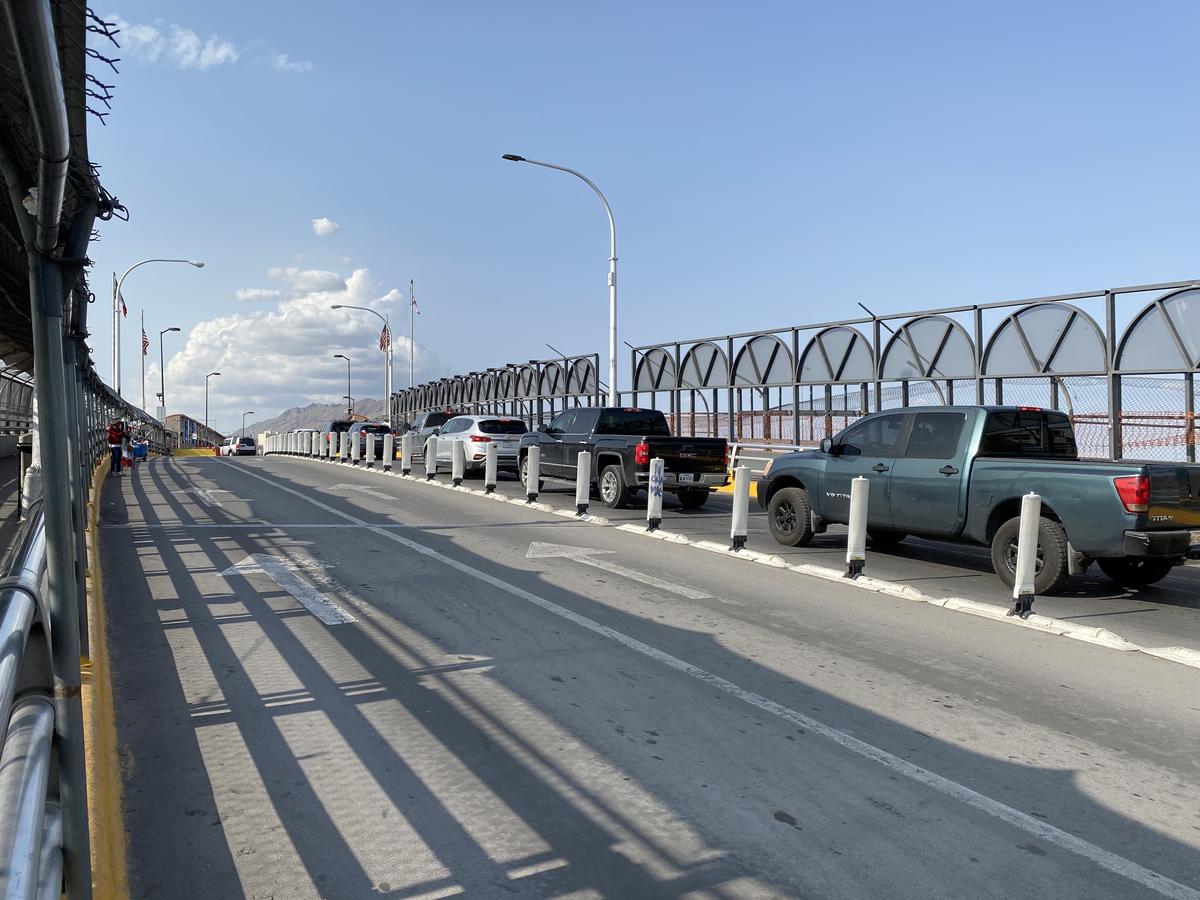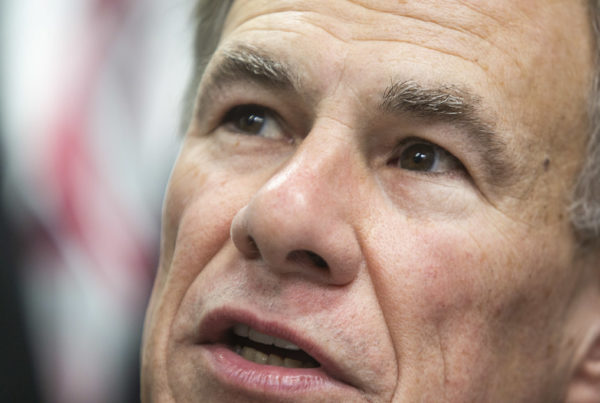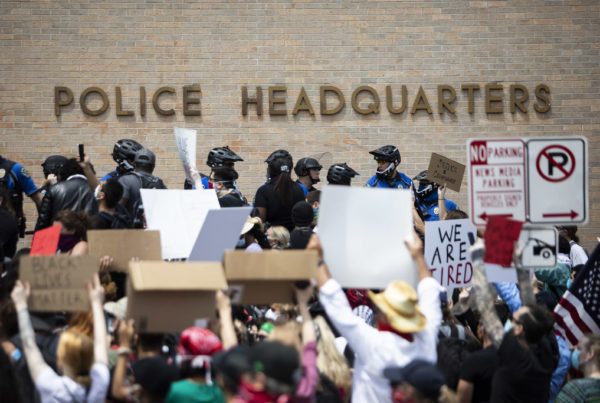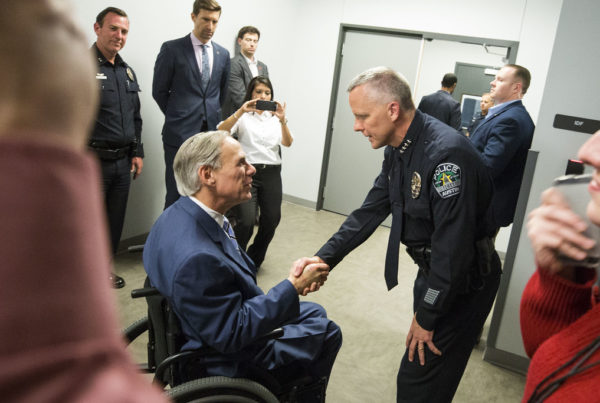From KTEP:
It’s been more than six months since the U.S. and Mexico border closed to all but essential travel to slow the spread of COVID-19. The disruption of lives and livelihoods has been widespread on both sides during the pandemic.
Marco Antonio Corral, 60, has watched it all unfold from the middle of the Paso del Norte Bridge where just over the borderline on the Mexican side he peddles potato chips and cold water to drivers and passengers stuck in idling cars calling out “Papitas! Agua!”
The father of five says his sales have been cut in half since the shutdown started in March. “It’s not right that Mexicans can’t cross. They should close it to everyone to be fair,” said Corral.
Some U.S. citizens and legal permanent residents continue to go back and forth across the border. Mexican authorities do not stop visitors and U.S. Customs and Border Protection cannot prevent Americans from returning home from Mexico.
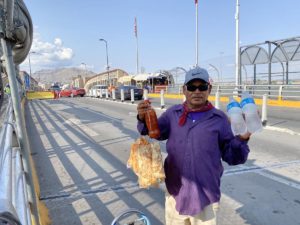
Marco Antonio Corral sells cold water and snacks to people waiting in line on the Paso del Norte international bridge linking El Paso and Ciudad Juarez.
Credit Angela Kocherga / KTEP News
On a recent afternoon, a line of cars and trucks waits to enter from Juarez and in El Paso people gather near the pedestrian entrance headed to Mexico. Marisol Marin crosses back and about three times a week to work in El Paso. She’s a U.S. citizen but lives in Juarez. “It’s a little bit difficult, but I try my best,” she said.
The 30-year-old helps her parents and supports three children working in El Paso. She brought her youngest child, five-year old fidgety Camila, with her to work on this day. “I clean houses over here” she said.
Work, medical treatment, and education are among the essential reasons for crossing the border. After a hard day’s work, Marin is trying to figure out how to carry her grocery bags across the border with Camila in tow. Marin is not complaining. She knows plenty of Mexican citizens who can’t come to El Paso at all with the travel restrictions in place. “I feel sorry for them,” she said.
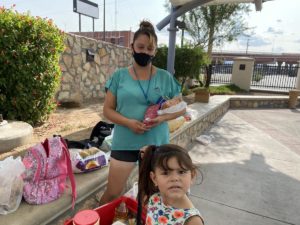
Marisol Marin and her daughter Camila gather their belongings at the Paso del Norte International bridge before walking across to Mexico. Marin is a U.S. citizen who works in El Paso and lives in Juarez.
Credit Angela Kocherga / KTEP News
Just across the bridge on Avenida Juarez, a ragtag group of older musicians plays songs for tips. Alejandra Guerrero listens as she waits in her truck to return to El Paso. She’s in the line of cars that stretches down the bridge and pass the toll booth into Mexico.
“The most I’ve had to wait is five hours,” said Guerrero. The 26-year-old mother of two crosses the border a couple times a month. “I come and visit my husband, yeah.
He’s waiting for a visa to join her in Texas. U.S. Customs and Border Protection discourages U.S. citizens and legal permanent residents from visiting Mexico during the pandemic. Part of the strategy includes staffing fewer booths and closing bridge lanes at border crossings, so people are forced to wait longer to get home.
“The goal is to reduce travelers from boing back and forth, ideally reduce COVID-19 or do our part to slow it down,” said U.S. Customs and Border Protection officer Adriana Carranza.
CBP conducted a survey in August of 100,000 people at ports of entry all along the southwest border returning to the U.S. “The vast majority of the travelers going back and forth to Mexico and back into the US were actually going for non-essential reasons, visiting family, maybe shopping, maybe eating out, reasons not deemed essential,” said Carranza.
The historic Kentucky Club is not getting the usual crowd of customers from El Paso. The restaurant bar has COVID-19 protocols in place. A guard at the door takes customers temperatures before they can enter and offers a generous squirt of hand sanitizer as ranchera music blares. Inside nearly all of those enjoying a late lunch are locals from Juarez.
El Pasoans and other U.S. citizens are still crossing to go pharmacies, doctors and dentists in Juarez because medical care and prescription drugs cost much less in Mexico. Pedro Geronimo Perez sees this firsthand. He pushes a wheelchair with a handwritten “Uber” sign on it and works for tips. He helps older people across the bridge. Many have appointments with doctors or dentists.
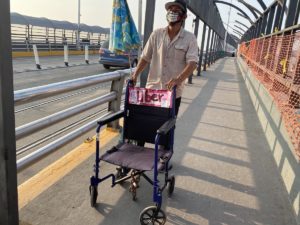
Pedro Geronimo Perez works for tips on the Paso del Norte international bridge offering wheelchair “Uber” service to older border crossers from El Paso. Many go Juarez to see doctors and dentists because medicalcare is much cheaper in Mexico.
Credit Angela Kocherga / KTEP News
“As the operator of this wheelchair I have to practice good hygiene,” he said. Perez wears a mask and proudly shows off his big bottle of hand sanitizer. He said his wheelchair Uber service is still in demand.
But on the El Paso side of the border, it’s a different story. Shopping is not an essential reason to cross the border and the shutdown has devastated retailers that depend on customers from Mexico.
“Somewhere in the neighborhood of $100 million in lost retail sales have likely occurred in El Paso alone during the past 6 months because of the non-essential border crossing restrictions,” said University of Texas economics professor Tom Fullerton.
An expert on the Paso del Norte region’s border economy, Fullerton estimates between 8 to 14 percent of all retail sales in El Paso are to shoppers from northern Mexico. The region was already coping with a recession and weak peso.
“If the current longer wait time policy remains in effect through December, the merchant losses on this side of the border will be even greater,” he said. Some of those Mexican shoppers are now looking for deals online since they can’t cross the border. “Of course, Alibaba and Amazon will celebrate the increased sales volumes that accrue to those conglomerates at the expense of Texas retail businesses in El Paso, McAllen, and San Marcos,” said Fullerton.
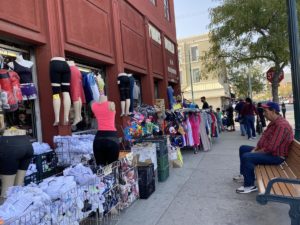
Businesses in El Paso near the Paso del Norte International bridge depend on customers from Mexico and have seen sales decline sharply in the six months since the border shutdown to non-essential travel including shopping.
Credit Angela Kocherga / KTEP News
Sergio Gonzalez has seen business at his clothing store on South El Paso street decline by 75 percent since the shutdown. His store is just a block from the international bridge and depends heavily on shoppers from Mexico. He has been forced to slash prices on already discounted merchandise “just to survive.”
Gonzalez’s message for U.S. and Mexican authorities: “hurry and reopen the border” in time for the holiday season before businesses are forced to permanently close.


